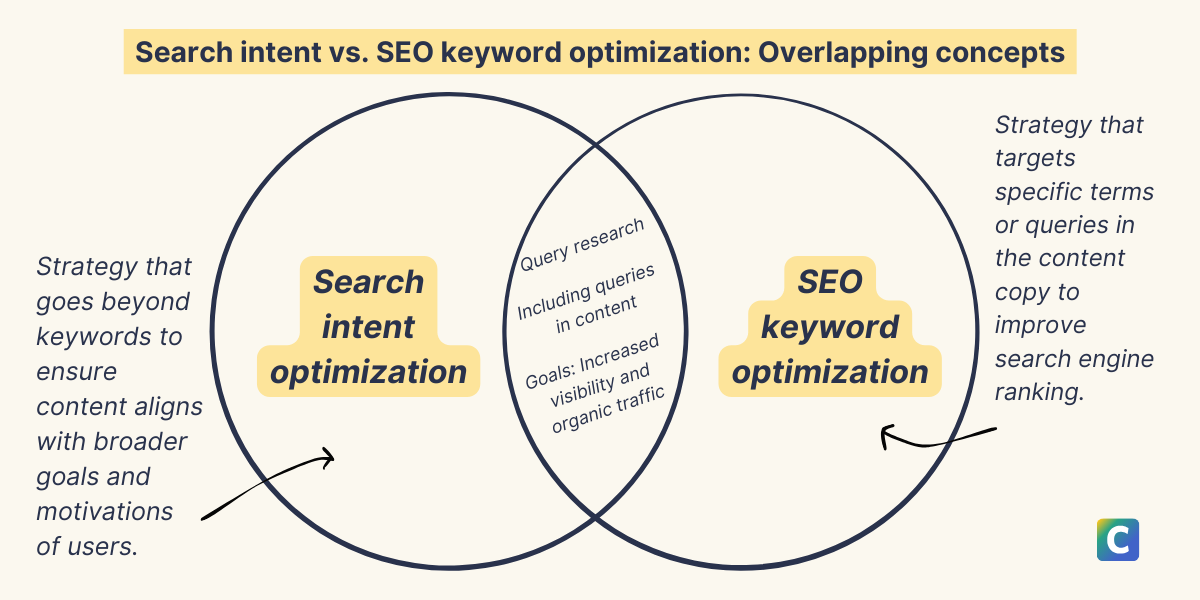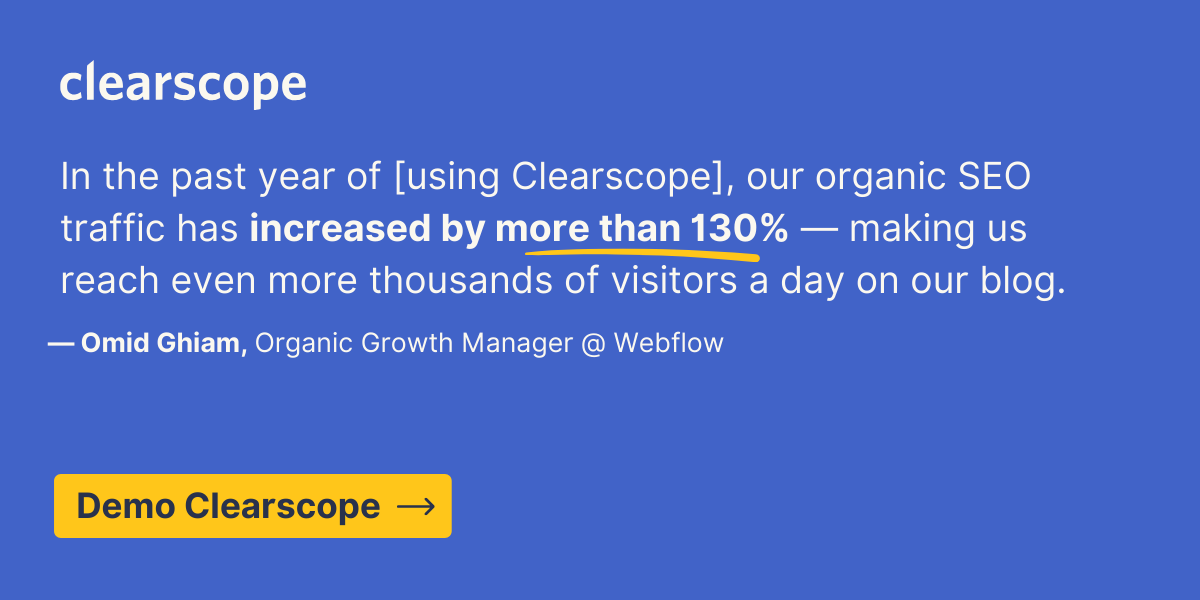What Is Content Optimization and Why It Matters for SEO
Topic: Content Marketing
Published:
Written by: Bernard Huang
TL;DR: What Is Content Optimization?
Content optimization refers to the process of enhancing and refining your website content to make it more accessible, relevant, and valuable to your target audience.
This involves various elements like incorporating relevant keywords, improving readability, adding metadata, and using visuals effectively.
It's all about making your piece of content shine in the eyes of both users and search engines.
Key Components of Implementing Content Optimization
Key components of content optimization include:
SEO keywords: Selecting and strategically placing target keywords and related keywords sharply tied to your target user’s search intent within your content to improve its relevance and visibility.
Metadata: Crafting compelling meta titles and meta descriptions that accurately describe your page content and encourage clicks.
Visuals: Utilizing images, videos, and infographics to enhance user engagement and convey information more effectively. Don't forget to optimize image tags and descriptions for better SEO.
Headers and subheadings: Structuring content with headings, subheadings, and bullet points—and even a table of contents if it assists users—for better readability and SEO. This structure helps crawlers understand your content's hierarchy and relevance and users navigate the context of the page.
Internal Links and backlinks: Including links to other parts of your website and acquiring backlinks to your new content from reputable sites to boost domain authority.
Why Content Optimization Matters for SEO
Impact on Search Engine Rankings
Content optimization is crucial for improving your search engine rankings on Search Engine Results Pages (SERPs).
By optimizing for relevant keywords and following best practices, your content can achieve higher visibility, increasing the likelihood of appearing on the first page of Google Search, which significantly impacts page ranking.
Importance of Quality Content
High-quality content is a cornerstone of effective SEO.
Great content provides value to readers, answers their questions, and meets their search intent.
It helps establish your authority in your niche and builds trust with your audience.
LEARN MORE: Why search intent optimization beats keyword optimization
Role in Driving Organic Traffic
Optimized content is key to driving organic search traffic to your website.
By aligning your content with the search intent of users and optimizing it for specific search terms closely related to your targeted search intent, you can attract more visitors while reducing your spend on paid advertising (PPC) over time.
Enhancing User Experience (UX)
Content optimization isn't about pleasing search engines.
It's primarily about prioritizing the user experience.
A well-structured piece of content with clear headings, engaging visuals, and easy navigation keeps users engaged and reduces bounce rates.
Connection to Search Intent and Target Audience
Understanding and addressing the primary search intent(s) of your target audience is vital.
By optimizing your content for specific search queries, you can ensure that your content meets the needs and expectations of your audience, leading to better conversions and engagement.

Search intent optimization and keyword optimization are overlapping but differing concepts. Understanding both are important to your overall content optimization strategy.
How Does Content Optimization Work?
Content optimization works as an integral part of a broader digital marketing strategy.
It involves a series of techniques and tools aimed at making your content more appealing and accessible to both search engines and users.
Keyword Research and Selection
The content optimization process often begins with keyword research, where you identify high-volume and relevant keywords that your target audience is searching for.
Traditional SEO tools like Ahrefs and SEMrush are invaluable for discovering the right keywords to target and for effective link building.
And tools like Clearscope’s Topic Exploration feature can help you find related terms that offer less competitive opportunities that sharply target search intent.
On-Page SEO Techniques (Title Tags, Meta Descriptions, etc.)
Foundational on-page SEO techniques involve crafting effective title tags, meta descriptions, and alt text for images.
These elements help search engines understand the content of your page and can improve click-through rates (CTR) from the SERPs.
Content Structure (Headings, Subheadings, Bullet Points)
A clear and organized content structure improves readability and helps search engines crawl your content more efficiently.
Use headings, subheadings, and bullet points to break down information and guide readers through your content.
This approach can be particularly effective for creating featured snippets, which elevate your top-ranking content's visibility.
Internal Links and Backlinks
Incorporating internal links helps distribute link equity throughout your site and improves the discoverability of other pages.
Backlinks from authoritative sites boost your site's credibility and improve its ranking potential, contributing to a higher domain authority.
Utilizing Multimedia (Images, Videos, Infographics)
Multimedia elements like images, videos, and infographics make your webpage content more engaging and shareable.
They also can improve the time users spend on your page, which can positively impact your search rankings.
Don't forget to prioritize mobile devices in your content optimization strategy, ensuring a seamless user experience across all platforms.
Measuring Results
Monitoring and analyzing the performance of your content is crucial.
Key performance indicators (KPIs) like organic traffic, bounce rates, and conversions help you gauge the effectiveness of your content optimization efforts.
SEO content optimization isn't a one-time task—it’s an ongoing process of fine-tuning and updating your content.
The Role of E-E-A-T (Experience, Expertise, Authoritativeness, Trustworthiness)
E-E-A-T is a crucial factor in Google's ranking algorithms.
It stands for Experience, Expertise, Authoritativeness, and Trustworthiness.
By demonstrating these qualities in your content, you can enhance your site's credibility and improve its chances of ranking well.
This can involve having qualified authors, offering fresh perspectives, citing reputable sources, and providing accurate, reliable information, which is essential for any in-depth content.
Best Practices for Content Optimization
Create High-Quality Content
Focus on producing valuable content that provides genuine insights and solutions and follows E-E-A-T best practices.
High-quality content naturally attracts links and shares, boosting your SEO efforts.
Avoid Keyword Stuffing
Keyword stuffing, or overusing keywords on a page, can harm your SEO strategy.
Instead, use relevant keywords naturally within your content to maintain readability and relevance.
Balancing keywords with related terms can help maintain a natural flow and avoid penalties.
Write for Searchers First and Search Engines Second
Prioritize the needs and interests of your audience.
Create content that answers their questions and solves their problems.
Optimizing for search engines should complement this approach, not dominate it.
The type of content you produce should align with the preferences of your target audience.
Use Metadata Effectively
Crafting compelling and accurate meta titles, descriptions, and alt tags is essential for SEO.
They provide search engines and users with a snapshot of your content.
Proper use of metadata is a key aspect of technical SEO, helping ensure your content is properly indexed.
Craft Engaging Call to Actions (CTAs)
Incorporate clear and compelling CTAs to guide users toward the desired action, whether it's signing up for a newsletter, downloading a resource, or making a purchase.
Regularly Update and Refresh Existing Content
Content optimization is an ongoing process.
Regularly updating and refreshing your content ensures it remains relevant, accurate, and aligned with current search intent and search engine algorithms.
This practice is particularly important for maintaining and improving your page ranking.
Additional Insights on Content Optimization
Understanding Search Engine Algorithms
Staying updated with the latest changes in search engine algorithms is crucial for maintaining and improving your SEO efforts.
Algorithms like Google's prioritize content that demonstrates E-E-A-T and aligns with user intent.
Tools and Resources
Tools like Clearscope—or traditional SEO keyword research tools like Ahrefs, SEMrush, and Moz—offer valuable insights into keyword research, content quality, competing pages, and overall SEO performance.
These resources are essential content optimization tools that can help you refine your strategies.

The Impact of Social Media on SEO
While social media signals aren't a direct ranking factor, a strong social media presence can enhance your content's visibility and drive traffic, indirectly supporting your SEO goals.
Planning a Content Marketing Strategy
A well-rounded content marketing strategy integrates SEO best practices, regular content creation, and distribution across various channels.
It ensures a steady flow of high-quality, optimized content that meets the needs of your audience.
Beginners in SEO should focus on developing a cohesive strategy that balances different elements of content optimization.
Common Questions About Content Optimization
How do I avoid keyword stuffing while still optimizing my content?
Focus on using keywords naturally and in context.
Instead of forcing keywords into your content, prioritize meeting search intent, increasing readability, and incorporating fresh perspectives.
Instead of overusing phrases, use synonyms and related terms to keep the content engaging. Monitoring word count can also help maintain a balance.
Clearscope’s Content Drafts tool can help you do all these things in a streamlined way—saving you tons of time in your content optimization process.
What is the difference between on-page and off-page SEO?
On-page SEO involves optimizing elements on your website, such as content, meta tags, and internal links.
Off-page SEO focuses on external factors like backlinks, public relations (PR), and social signals that affect your site's authority and ranking.
What are the benefits of using long-tail keywords in my content?
Long-tail keywords are specific phrases that typically have lower search volume but higher intent.
They help you target niche audiences and are often less competitive, making it easier to rank.
How should long-tail keywords play into your information gain SEO strategy? Read information gain vs. long-tail keywords to learn more.
How can I track the effectiveness of my content optimization efforts?
Use tools like Clearscope’s Content Inventory, Google Analytics, and Google Search Console to monitor metrics such as organic traffic, content health, content decay, engagement rates, and keyword rankings.
These insights help you measure the success of your optimization strategies and guide future marketing efforts.
What are some common content optimization mistakes to avoid?
Avoid keyword stuffing, neglecting mobile optimization, and relying on AI generated content to game the SERPs.
Additionally, ensure your content is up-to-date and aligns with your audience's current interests and needs.
Utilizing case studies and real experiences can provide practical examples and reinforce your content's credibility.
Additional Resources and Citations
1. Creating Helpful, Reliable, People-First Content from Google Search Central
2. Mobile-first Indexing Best Practices from Google Search Central
3. Alt Text SEO: Why is Alt Text Important? from Moz
4. Is Fresh Content A Google Ranking Factor? from Search Engine Journal
What Is Content Decay and Why It Matters for SEO
Discover what content decay is and why it matters for SEO. Understand its impact and learn best practices to combat it for sustained website health and performance.
Read moreHow to Create a Content Inventory & Perform a Content Audit
Our post explains how to perform a content inventory, audit your existing website content, and maintain an SEO-optimized site — in four simple steps.
Read moreWhy Search Intent Optimization Beats Keyword Optimization
Optimizing for search intent vs. SEO keywords: Which is better? Explore the difference between keyword and intent-based SEO strategies.
Read more